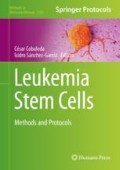Abstract
Next-generation sequencing (NGS) of immunoglobulin (IG) and T cell receptor (TR) rearrangements represents a modern alternative to classical RQ-PCR-based minimal residual disease (MRD) detection. The same primer sets and conditions can be used for all patients, which is undoubtedly one of the most important benefits of NGS, not only reducing the labor required to perform the analysis but also enabling the assay to comply with the upcoming EU IVD regulation. So far, only one standardized academic protocol for this task has been published, developed, and validated within the EuroClonality-NGS working group. In this chapter we describe the materials and methods for amplicon library preparation for sequencing on Illumina MiSeq, and the bioinformatic pipeline for this protocol.
Access this chapter
Tax calculation will be finalised at checkout
Purchases are for personal use only
References
van der Velden VHJ, van Dongen JJM (2009) MRD detection in acute lymphoblastic leukemia patients using Ig/TCR gene rearrangements as targets for real-time quantitative PCR. In: Methods in molecular biology, Clifton, NJ, pp 115–150
van der Velden VHJ, Cazzaniga G, Schrauder A et al (2007) Analysis of minimal residual disease by Ig/TCR gene rearrangements: guidelines for interpretation of real-time quantitative PCR data. Leukemia 21:604–611. https://doi.org/10.1038/sj.leu.2404586
Gomez-Arteaga A, Guzman ML (2018) Minimal residual disease in acute myeloid leukemia. In: Advances in experimental medicine and biology. National Center for Biotechnology Information, Bethesda, MD, pp 111–125
Schuurhuis GJ, Heuser M, Freeman S et al (2018) Minimal/measurable residual disease in AML: a consensus document from the European LeukemiaNet MRD Working Party. Blood 131:1275–1291. https://doi.org/10.1182/blood-2017-09-801498
Voso MT, Ottone T, Lavorgna S et al (2019) MRD in AML: the role of new techniques. Front Oncol 9:655. https://doi.org/10.3389/fonc.2019.00655
Steensma DP (2018) Clinical consequences of clonal hematopoiesis of indeterminate potential. Hematology 2018:264–269. https://doi.org/10.1182/asheducation-2018.1.264
Karner K, George TI, Patel JL (2019) Current aspects of clonal hematopoiesis: implications for clinical diagnosis. Ann Lab Med 39:509. https://doi.org/10.3343/alm.2019.39.6.509
Brüggemann M, Kotrová M, Knecht H et al (2019) Standardized next-generation sequencing of immunoglobulin and T-cell receptor gene recombinations for MRD marker identification in acute lymphoblastic leukaemia; a EuroClonality-NGS validation study. Leukemia. 33(9):2241–2253. https://doi.org/10.1038/s41375-019-0496-7
Kotrova M, Muzikova K, Mejstrikova E et al (2015) The predictive strength of next-generation sequencing MRD detection for relapse compared with current methods in childhood ALL. Blood 126:1045. https://doi.org/10.1182/BLOOD-2015-07-655159
Faham M, Zheng J, Moorhead M et al (2012) Deep-sequencing approach for minimal residual disease detection in acute lymphoblastic leukemia. Blood 120:5173–5180. https://doi.org/10.1182/blood-2012-07-444042
Wu D, Sherwood A, Fromm JR et al (2012) High-throughput sequencing detects minimal residual disease in acute T lymphoblastic leukemia. Sci Transl Med 4:134ra63–134ra63. https://doi.org/10.1126/scitranslmed.3003656
Wu D, Emerson RO, Sherwood A et al (2014) Detection of minimal residual disease in B lymphoblastic leukemia by high-throughput sequencing of IGH. Clin Cancer Res 20:4540–4548. https://doi.org/10.1158/1078-0432.CCR-13-3231
Carlson CS, Emerson RO, Sherwood AM et al (2013) Using synthetic templates to design an unbiased multiplex PCR assay. Nat Commun 4:2680. https://doi.org/10.1038/ncomms3680
Knecht H, Reigl T, Kotrová M et al (2019) Quality control and quantification in IG/TR next-generation sequencing marker identification: protocols and bioinformatic functionalities by EuroClonality-NGS. Leukemia 33(9):2254–2265. https://doi.org/10.1038/s41375-019-0499-4
Bystry V, Reigl T, Krejci A, et al (2016) ARResT/Interrogate: an interactive immunoprofiler for IG/TR NGS data. Bioinformatics 33:btw634. doi:https://doi.org/10.1093/bioinformaticsBioinformatics/btw634
Author information
Authors and Affiliations
Consortia
Corresponding author
Editor information
Editors and Affiliations
Rights and permissions
Copyright information
© 2021 Springer Science+Business Media, LLC, part of Springer Nature
About this protocol
Cite this protocol
Kotrova, M., Darzentas, N., Pott, C., Brüggemann, M., On Behalf of the EuroClonality-NGS Working Group. (2021). Next-Generation Sequencing Technology to Identify Minimal Residual Disease in Lymphoid Malignancies. In: Cobaleda, C., Sánchez-García, I. (eds) Leukemia Stem Cells. Methods in Molecular Biology, vol 2185. Humana, New York, NY. https://doi.org/10.1007/978-1-0716-0810-4_7
Download citation
DOI: https://doi.org/10.1007/978-1-0716-0810-4_7
Published:
Publisher Name: Humana, New York, NY
Print ISBN: 978-1-0716-0809-8
Online ISBN: 978-1-0716-0810-4
eBook Packages: Springer Protocols

